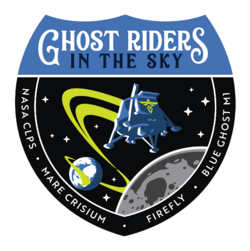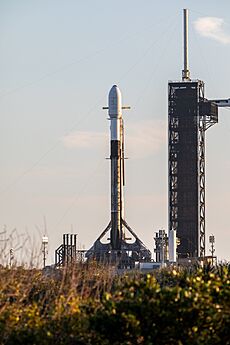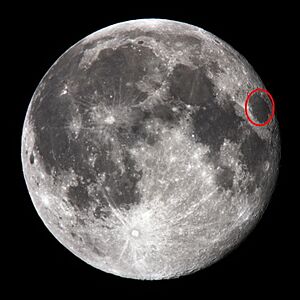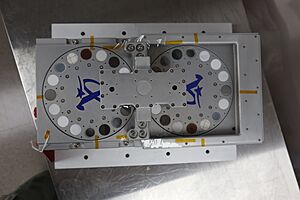Blue Ghost Mission 1 facts for kids

Rendering of Blue Ghost Mission 1 on the Moon
|
|
| Names |
|
|---|---|
| Mission type | Lunar landing |
| Operator | Firefly Aerospace |
| Mission duration | 2 months and 1 day |
| Spacecraft properties | |
| Spacecraft type | Blue Ghost |
| Manufacturer | Firefly Aerospace |
| Launch mass | 1,517 kg (3,344 lb) |
| BOL mass | 1,469 kg (3,239 lb) |
| Dry mass | 469 kg (1,034 lb) |
| Dimensions | Height: 2 m (6 ft 7 in) Width: 3.5 m (11 ft) |
| Power | 400 watts |
| Start of mission | |
| Launch date | 12:52, December 8, 2025 (ET) () (January 15, 2025, 06:11:39 UTC) |
| Rocket | Falcon 9 Block 5 (B1085‑5), Flight 425 |
| Launch site | Kennedy, LC-39A |
| Contractor | SpaceX |
| End of mission | |
| Last contact | March 16, 2025, 23:25 UTC |
| Lunar lander | |
| Landing date | March 2, 2025, 08:34 UTC |
| Landing site | Mare Crisium near Mons Latreille 18°34′N 61°49′E / 18.56°N 61.81°E |
 Mission insignia Firefly Aerospace Blue Ghost
|
|
Blue Ghost Mission 1 was a robotic mission to the Moon by Firefly Aerospace. It launched on January 15, 2025, and successfully landed on the lunar surface on March 2, 2025. This made Firefly Aerospace the first company to achieve a fully successful soft landing on the Moon. Another company, Intuitive Machines, had landed a spacecraft in February 2024, but it tipped over.
This mission was part of NASA's Commercial Lunar Payload Services (CLPS) program. Its goal was to deliver ten science tools and technology tests to the Moon. These experiments helped prepare for future human exploration under the Artemis program. The Blue Ghost lander used solar power. Its mission ended on March 16, 2025, when the sun set on the Moon, its batteries ran out, and communication was lost.
The Blue Ghost lander launched from Kennedy Space Center on a SpaceX Falcon 9 Block 5 rocket. This rocket also carried another lunar lander called Hakuto-R Mission 2. Blue Ghost delivered its science tools to Mare Crisium, a large basin on the Moon about 500 kilometers (310 miles) wide. The mission lasted about 14 Earth days, which is one lunar day. During this time, it studied the Moon's surface material (called regolith), its physical features, and how the solar wind interacts with Earth's magnetic field.
Mission Journey
In February 2021, NASA gave Firefly a contract worth $93.3 million. This contract was to send ten science and technology experiments to the Moon. This was part of the Commercial Lunar Payload Services (CLPS) program. Through CLPS, NASA works with private companies to quickly send science tools to the Moon. This helps with the Artemis program, which aims to send humans back to the Moon.
In May 2021, Firefly Aerospace chose SpaceX's Falcon 9 Block 5 rocket for its first Blue Ghost mission. The Falcon 9 was chosen because it could carry more weight than Firefly's own Alpha rocket. Firefly plans to use its future larger rocket for later Blue Ghost missions.
The Blue Ghost lander was developed over several years. By April 2022, Firefly had completed a key review for the lander. The launch was planned for 2024. In November 2023, the launch was set for late 2024.
By May 2024, the engines for Blue Ghost were ready. They were installed on the lander in June. Firefly confirmed that everything was on track for a late 2024 launch. In August, the lander went through special tests at NASA's Jet Propulsion Laboratory (JPL). These tests made sure it could handle the harsh conditions of space.
In November 2024, Firefly Aerospace announced that the Blue Ghost lander was ready. They set the launch date for mid-January 2025. The science tools were placed inside the lander on January 10. On January 15, 2025, the Blue Ghost lander successfully launched from Kennedy Space Center Launch Complex 39A. It launched at 6:11:39 AM UTC on a SpaceX Falcon 9 Block 5 rocket. The Hakuto-R Mission 2 lander also launched on the same rocket.
The spacecraft orbited Earth for 25 days. Then, it performed a maneuver to travel towards the Moon. Four days later, it entered orbit around the Moon. After orbiting the Moon for 16 more days, Blue Ghost landed successfully on March 2, 2025. It landed northwest of Mons Latreille. Firefly Aerospace became the first commercial company to achieve a fully successful soft landing on the Moon. The mission lasted about 14 Earth days, which is one lunar day. This was until the lunar sunset caused temperatures to drop very low, around -280 degrees Fahrenheit (-173 degrees Celsius). Three solar panels powered the lander's instruments during this time.
Lander Design
The Blue Ghost lander was built with many parts made by Firefly itself. These included its main body, support beams, landing legs, and footpads. It had a special system to control its temperature using heaters and sensors. The lander's computers and batteries were also designed by Firefly. Its solar panels, made by SolAero, could produce up to 400 watts of power.
The lander used a main engine called LEROS-4 and smaller thrusters for steering. It could communicate with Earth using two types of radios. It sent data to ground stations operated by the Swedish Space Corporation. Firefly also put the entire spacecraft together in its cleanroom in Cedar Park, Texas. They also tested it at the Jet Propulsion Laboratory in a special vacuum chamber. Firefly is proud that they built and tested most of the Blue Ghost lander themselves.
Science Tools
The Blue Ghost mission landed in Mare Crisium, a large basin on the Moon that can be seen from Earth. The lander's science tools collected information about the Moon's regolith (loose rock and soil). They also studied the Moon's physical features and how the solar wind interacts with Earth's magnetic field. This information will help scientists prepare for future human missions to the Moon.
The science tools weighed about 94 kilograms (207 pounds) in total. Here are some of them:
- The Regolith Adherence Characterization (RAC) tool checked how much lunar dust sticks to different materials. This is important for things like solar panels and camera lenses.
- The Next Generation Lunar Retroreflectors (NGLR) are special mirrors. Lasers from Earth can bounce off them to measure the exact distance to the Moon. This also helps scientists learn about the Moon's inside and answer big physics questions.
- The Lunar Environment Heliospheric X-ray Imager (LEXI) took pictures of how Earth's magnetosphere (its magnetic shield) interacts with charged particles from the Sun (the solar wind).
- The Reconfigurable, Radiation Tolerant Computer System (RadPC) tested a computer designed to work well even with lots of radiation. The Moon has no atmosphere or strong magnetic field, so radiation from the Sun is a big challenge for electronics.
- The Lunar Magnetotelluric Sounder (LMS) was designed to study the Moon's inner layers by looking at electric and magnetic fields. It launched electrodes across the surface to do this.
- The Lunar Instrumentation for Subsurface Thermal Exploration with Rapidity (LISTER) measured heat coming from inside the Moon. It tried to drill 7 to 10 feet (2 to 3 meters) into the lunar soil to check its temperature at different depths.
- The Lunar PlanetVac (LPV) was designed to collect lunar soil from the surface. It could then transfer the soil to other instruments for analysis or put it in a container for a future mission to bring back to Earth.
- The Stereo CAmeras for Lunar Plume Surface Studies (SCALPSS 1.1) took videos and pictures of the area under the lander. It watched from when the rocket engine first disturbed the lunar surface until it shut down. This helps scientists understand how rocket exhaust affects the Moon's surface and how to avoid kicking up too much dust during future landings.
- The Electrodynamic Dust Shield (EDS) created an electric field to push away dust particles. This technology could be used for things like spacesuits, camera lenses, and solar panels.
- The Lunar GNSS Receiver Experiment (LuGRE) successfully received signals from GPS and Galileo satellites while near and on the Moon. This showed that these navigation systems could work for future lunar missions.
See also
 In Spanish: Blue Ghost Mission 1 para niños
In Spanish: Blue Ghost Mission 1 para niños
- Chandrayaan-3
- Commercial Lunar Payload Services
- List of missions to the Moon
- Luna 25
- Peregrine Mission One
- Smart Lander for Investigating Moon




